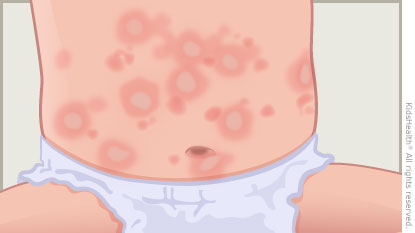Erythema Multiforme: How to Care for Your Child
Erythema multiforme (air-uh-THEE-muh mul-ti-FOR-mee) is a reaction of the body's immune system to an infection, medicine, or another health problem. Red blotches on the skin develop into spots that look like a target or a "bull's-eye." Some of the spots have blisters in the center. They tend to appear first on the arms, hands, legs, and feet, and then can develop on any part of the body. Some children get blisters on the lips and inside the mouth.
They can look alarming, but the spots usually do not bother kids. Sometimes they can burn or itch. Some kids also have a low-grade fever or achy joints or muscles.
The rash usually goes away on its own within a few weeks. The affected skin may look darker for a few months, but the rash won't leave a scar.


-
Give your child any prescribed medicines as instructed.
-
If your child is uncomfortable:
-
for fever or discomfort: You can give acetaminophen (Tylenol® or a store brand).
-
for itching and swelling: You can give an antihistamine, such as cetirizine (Zyrtec® or a store brand), fexofenadine (Allegra® or a store brand), or others.
-
Do not give aspirin to your child or teen as it has been linked to a rare but serious illness called Reye syndrome.
-
Put a cool, moist cloth on the rash to relieve itching.
-
Baths or showers should be cool or lukewarm, not hot.

Your child:

Your child:
-
has pain or blisters in or near the eye
-
has patches of skin peel off
-
appears dehydrated; signs include dizziness, drowsiness, a dry or sticky mouth, sunken eyes, peeing less often or darker than usual pee or having fewer wet diapers, crying with little or no tears

How is erythema multiforme treated? Treatment usually involves helping to relieve the symptoms if the child is uncomfortable. If a medicine might have caused the rash, your child should not take it again. Talk to your health care provider about other medicines that would be OK to use instead. Some viral infections can make the rash come back periodically. The health care provider might suggest taking a medicine every day to prevent that.